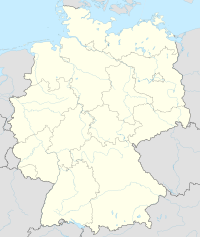Zinc-lead deposits in Wiesloch
 Mines and processing in the area | |
| Location | |
|---|---|
| Location | Wiesloch |
| State | Baden-Württemberg |
| Country | Germany |
| Coordinates | 49°18′N 8°43′E / 49.3°N 8.72°E |
| Production | |
| Products | |
| Type | Underground; Mississippi Valley-Type (MVT) |
| History | |
| Closed | 1953 |
| Owner | |
| Company | Stolberger Zink |
The area around Wiesloch, Germany, is a historical centre for mining, running between Roman times and the earlier 2000s. The area is situated on the eastern edge of the Upper Rhine Plain and contains large concentrations of carbonate-hosted lead-zinc ore deposits.[1] Lime (Kalk) for cement is still actively mined in the vicinity, with most of the clay pits closed, and the last heavy metal mine operated until 1953 by Stolberger Zink. On top of the escarpment metals and lime have been mined, with clay and sand mined at the end of the valley floor where faulting has brought different layers closer to the surface.

During the 11th century, around ~100 tonnes of silver is estimated to have been mined, contributing financially to the area and liking funding the creation of Speyer Cathedral.[2]
Along the length of the River Leimbach are spoil tips from historic mining.[2]
The Nussloch quarry extracting lime for cement and belonging to HeidelbergCement was anticipated to reach permitted limits for extraction during the late-2020s.[3]
Overview
[edit]The main mines in the vicinity of Wiesloch were:
- Nussloch quarry, lime, transported by the Nußloch–Leimen ropeway for processing by HeidelbergCement in Leimen
- Gottes Segen, zinc-silver deep mines, processed by Stolberger Zink on the surface at the Schafbuckel in Altwiesloch
- Hesseler quarry, processed at the Hessler Kalkwerke in Altwiesloch
- Dämmelwald clay pit, processed by Tonwaren-Industrie Wiesloch near Wiesloch-Walldorf station. Closed in 1988
- Nussloch clay pit, processed by Stauch at Nussloch
- Frauenweiler sand pit
- Frauenweiler clay pits, ×3, processed at Bott/Trost at Rauenberg
- Malsch clay pit, processed at Malsch
References
[edit]- ^ Schmidt, Adolf (1880-12-28). "Die Zinkerz-Lagerstaetten von Wiesloch (Baden)" [The Zinc deposits in Wiesloch]. Verhandlungen des Naturhistorisch-Medicinischen Vereins zu Heidelberg (in German). Vol. 2. Carl F. Winter. pp. 369‒490, 522, 524, 526. Archived from the original on 2009-01-26.
{{cite news}}: CS1 maint: unfit URL (link) - ^ a b Hebbelmann, Sabine (2015-04-25). "Als Wieslochs Bergwerke tonnenweise Silber lieferten" [When Wiesloch's mines delivered tonnes of silver]. Rhein-Neckar-Zeitung (in German). Retrieved 2020-04-11.
Und er erklärt, warum Plinius in der um 77 nach Christus fertig gestellten Naturgeschichte mit der Erwähnung "vor kurzem soll in Germanien Galmei gefunden worden sein" nur Wiesloch gemeint haben kann. … für das 11. Jahrhundert ausgemacht. Aus der Mächtigkeit der mittelalterlichen Abraumhalden schließt der Geologe auf eine Ausbeute von rund 100 Tonnen Silber. Das entspreche einem damaligen Wert von mehreren Milliarden Euro, sagt Hildebrandt und vermutet, der Speyerer Dom sei aus Wieslocher Silber bezahlt worden.
- ^ Hebbelmann, Sabine (2015-04-23). "Nußloch: In 15 Jahren ist Schluss im Steinbruch" [Nussloch: In 15 years the quarry will be closed]. Rhein-Neckar-Zeitung (in German). Retrieved 2020-04-11.
Further reading
[edit]- Holtz, Friedrich (January 2020). "Wiesloch". Stolberg - Alphabet der Heimatkunde [Stolberg ‒ Alphabet of local history] (in German). Stolberg: Zinkhütter Hof ‒ Museum für Industrie-, Wirtschafts- und Sozialgeschichte. Retrieved 2020-04-12.
Vielzahl von Störungen durchzogen, z.B. Rheingraben-Hauptverwerfung, Nußlocher Spalt, Schlangengrund-Verwerfung u. Baiertaler Sprung. … das Wieslocher Revier in die Teil-Lagerstätten Hessel, Kobelsberg u. Schanz gliedern
- Hildebrandt, Ludwig H. (2002). "Die Geschichte des Wieslocher Bergbaus im Überblick" [History of mining in Wiesloch at a glance] (PDF). Bergbau Rundweg [Mining circular walk]. Stadt Wiesloch. Retrieved 2020-04-12.
- Hildebrandt, Ludwig H. (1996). Nöltner, Thomas; Schöttle, Manfred (eds.). Schwermetallbelastungen durch den historischen Bergbau im Raum Wiesloch [Heavy metal pollution from historical mining in the Wiesloch area] (PDF) (Handbook). Materialien zum Bodenschutz. Vol. 7. Landesanstalt für Umweltschutz Baden-Württemberg. ISSN 0946-0659.
- Cerny, Immo; Geologische Abteilung der Bleiberger Bergwerks-Union (August 1989). "Die karbonatgebundenen Blei-Zink-Lagerstätten des alpinen und außeralpinen Mesozoikums: Die Bedeutung ihrer Geologie, Stratigraphie und Faziesgebundenheit für Prospektion und Bewertung" [The carbonate-hosted lead-zinc deposits of the Alpine and Extra-Alpine Mesozoic: The importance of their geology, stratigraphy and facies for prospecting and evaluation] (PDF). Archiv für Lagerstättenforschung der Geologischen Bundesanstalt (in German). 11. Vienna: 5‒125. ISSN 0253-097X.
- Schmidt, Adolf Franz (1880). "Die Zinkerz-Lagerstätten von Wiesloch (Baden)" [The Zinc-ore deposits of Wiesloch (Baden)]. Verhandlungen des Naturhistorisch-medizinischen Vereins zu Heidelberg (in German) (2): 369‒490.
- Pfaff, Katharina; Hildebrandt, Ludwig H.; Leach, David L.; Jacob, Dorrit E.; Markl, Gregor (2010). "Formation of the Wiesloch Mississippi Valley-type Zn-Pb-Ag deposit in the extensional setting of the Upper Rhinegraben, SW Germany". Mineralium Deposita. 45 (7): 647–666. doi:10.1007/s00126-010-0296-5. ISSN 0026-4598. S2CID 129430477.

